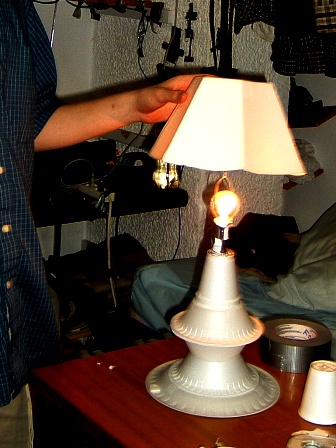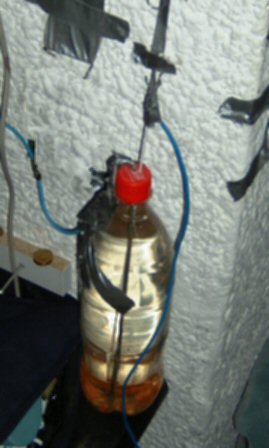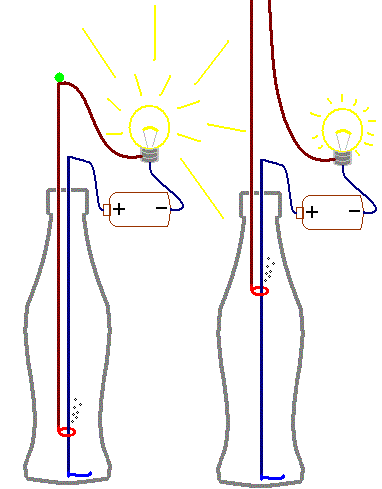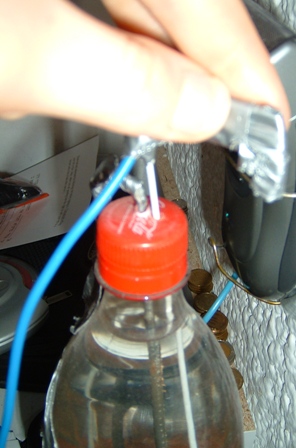Homemade electric lamp and dimmer
Description, 2003
 Lamp made from Styrofoam dishes and a plastic knife (+cheap/salvaged electric parts).
Lamp made from Styrofoam dishes and a plastic knife (+cheap/salvaged electric parts).
The Dimmer was made from
- 2 hangers
- duct tape
- coke bottle
It dimmed the lamp continuously from full brightness to a faint glow.
Motivation:
My roommate went to sleep early while I wanted to stay up. He couldn't sleep with the main light on so I made the lamp (it had a two way switch so I and a third roommate could turn it on and off from our beds). But then the Lamp was too bright, so I made a dimmer.


Left) lamp. Right) dimmer.
Base components:
LAMP: It was a challenge getting the lamp shade to be rigid; I installed a few struts made from plastic forks to add strength.
SWITCH: I had to buy the 2 two way switches necessary for the circuit. A nice electrician on campus told me which connector on the switch was the ground (saving lots of time for me).
WIRES: While walking around town in search of a hardware store, my roommate and I stumbled upon an some overhead power line segments that had been thrown out; a goldmine! We brought them back and ripped them apart. Each main wire had no less than 8 separate wires inside. Some of the leftover wires were donated to our surround sound system; my roommate also used some to make his own lamp out of a mug.
Dimmer:
It worked by placing a variable resistor into a series circuit with the light bulb.
Basic Mechanics: See
diagram below:
The electricity flowed from the "battery"
(wall outlet) along the dark blue wire (hanger) to the bottom
of the coke bottle. It was insulated with duct tape everywhere
except at the very bottom (colored light blue). Current then flowed
through the water to to second hangar (light-red=contact,
brownish-reddish=insulated). Then through the second hanger to the
light bulb than back to the battery/outlet.
by increasing or decreasing the distance between the blue and red
contacts (moving the green-dot on the brown-hangar up and down). Since this is the distance that the electricity flowed through, the amount of
resistance and (therefore the brightness of the bulb), increased or decreased. Hooks held the hanger steady at a variety of dimness levels.



Range:
At the brightest setting, the two contacts made a physical connection; it was as bright as ever. A friend of mine suggested the ring design to easily let the contacts touch at the bottom. When the hangar neared the top the light looked almost out.Resistor Choice:
I had experimented with a couple potential resistors before deciding to use water. (Graphite, i.e. pencil lead, turns out to be a rather good conductor.) Although the experiment gave me a rough estimate as to how much water it would need to go through, I was somewhat lucky for the dimming to work out so perfectly. The length, almost a foot, made for very accurate levels of dimness.A couple people have mentioned a viable strategy in case I had not been so lucky. Start with distilled water (a good insulator) and slowly add impurities (such as salt) until the desired resistance is reached.
Energy Dissipation:
When turned on, tiny bubbles would boil off of the contacts. The bottle did not heat up much and the bubbles often disappeared before reaching the top. I therefore think the bubbles were water vapor that then returned to liquid in the room temperature bottle. Some hydrolysis occurred (turning water into hydrogen and oxygen). I know this because of our unusually high pitched voices and the periodic explosions. That was a joke; I know it because of the major rust buildup in the bottle (the brownish color of this rust can be seen clearly in the rightmost picture). It was by no means a normal amount of rust, the rusted particles would peel off and amass on the bottom. If there was any hydrogen buildup my roommates and I were not aware.Extra Analysis:
It did not dim linearly. It dimmed faster as it got dimmer; dimming slowly near full brightness.I believe this was due to imperfect insulation on the brownish/reddish hangar (see diagram). It was insulated with naturally occurring hangar paint (2 hangers were harmed in the making of this dimmer). Near full brightness, electricity traveled through not only the light red contact, but through chips in the paint over the entire hangar surface area. Pulling the hanger out, did not change a large percentage of the surface area therefore not a big change of resistance. On the other hand, near the top, pulling it out just a bit more, made for a big percentage change of the available conducting surface area, therefore a big change in light brightness.
I would like to graph Lumens-vs-Meters once I learn a bit more about electricity and optics.